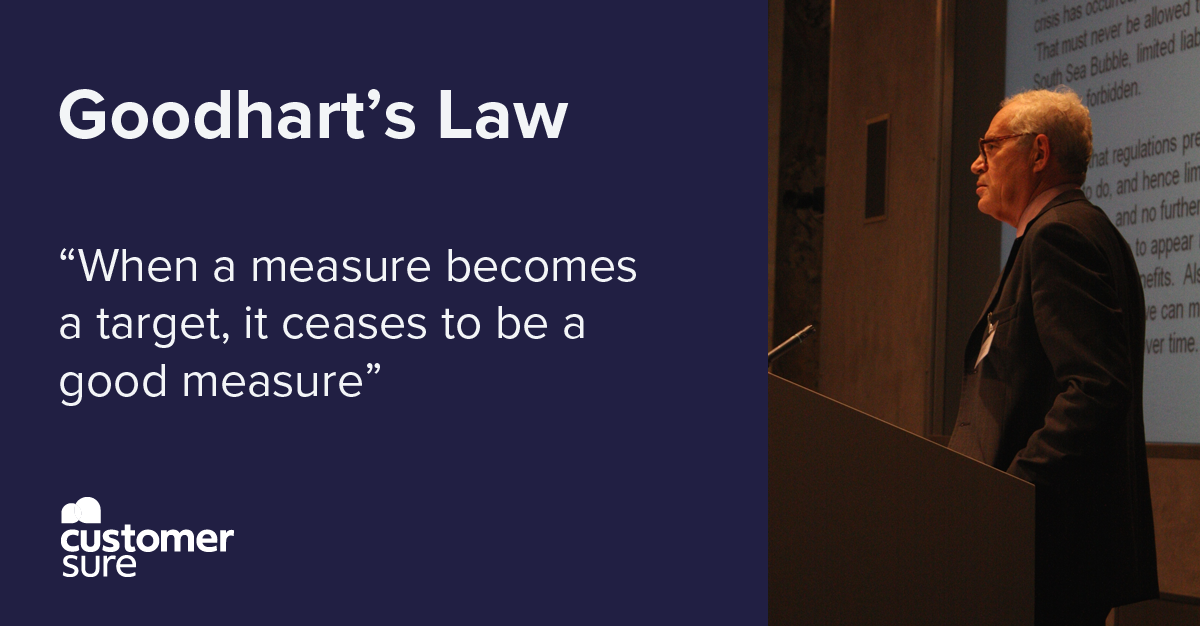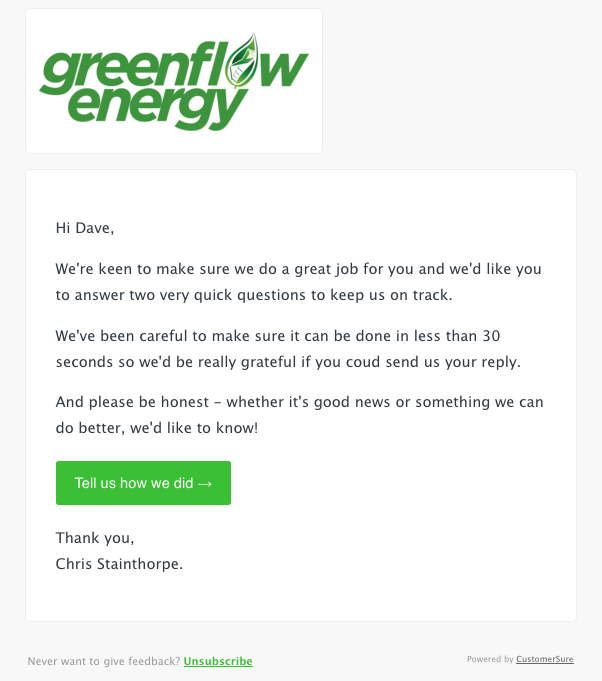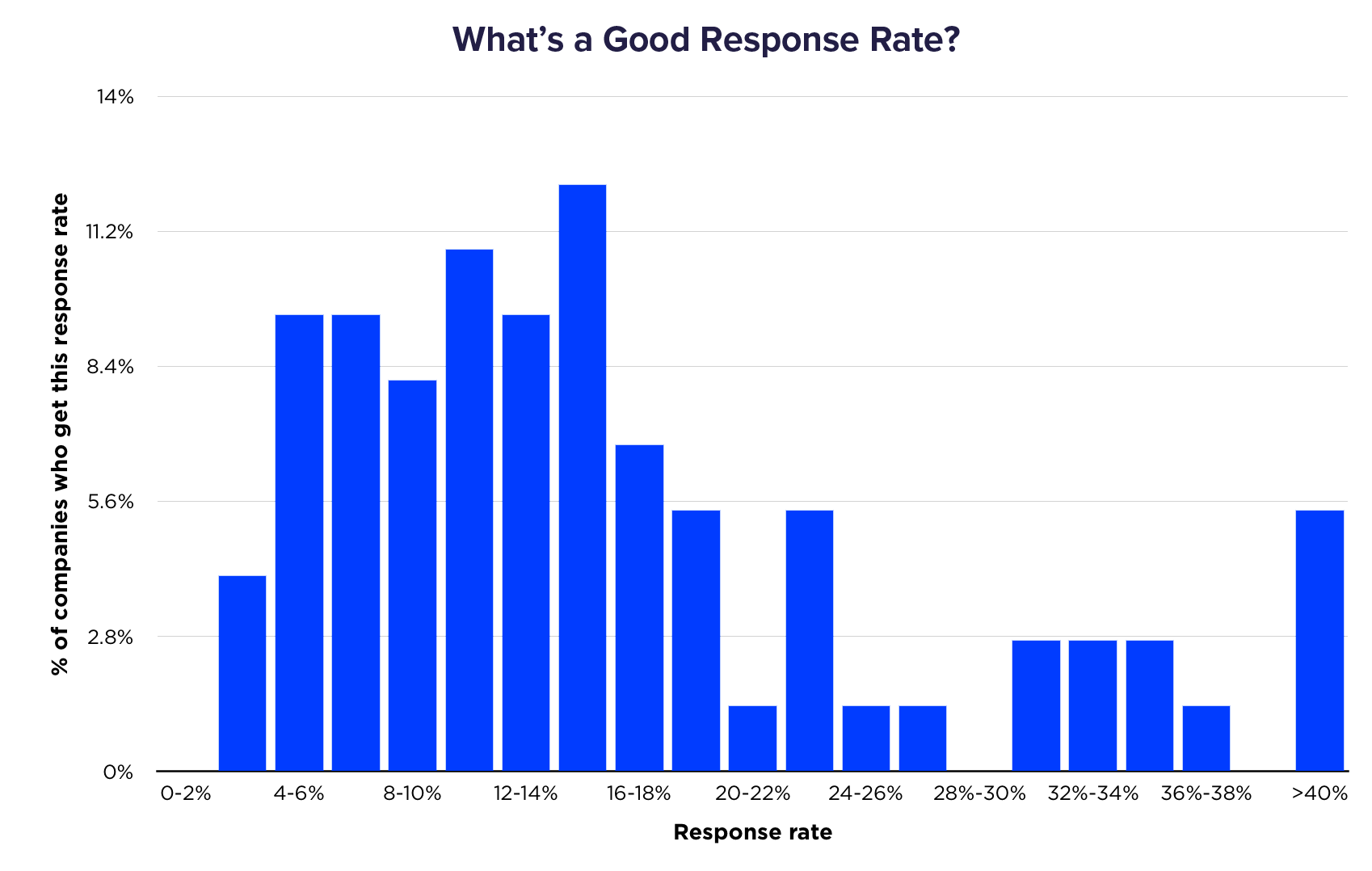

What is a good CSAT response rate?
There is an absolutely bulletproof method for calculating the exact response rate which is best for your survey, and your business.
To make this calculation work, you might have to let go of some assumptions you may hold dear, for instance:
If you can beat your competitor’s response rate, you’re doing well
A low response rate to a satisfaction survey is bad news
Your response rate is completely in your control
Your response rate is completely out of your control
You can know how much of your response rate is within your control, and how much is not.
But as soon as you accept all these things, the calculation works for any survey in any business in any industry.
Don’t believe us?
Here it is: The simple, two step calculation to find what a great response rate is for you:
Read, and implement all the advice in this guide.
Whatever response rate you now get is a great response rate.
Wait. Don’t get cross.
We’re deadly serious about this. Very often we meet people who are stressed about their response rate, but it really, truly,honestly doesn’t matter that much. Before you get cross, let us explain why.
We’ve supported hundreds of companies worldwide, in many different industries – so we do have some tips to share about how to get the healthiest response rate possible. (This is the all important step one in the ‘formula’ above). But trust us, after you’ve digested this guide, if your response rate is only 4%, you’ll still be delighted.
A healthy response rate is super-important for any market research survey. Along with good sampling technique, it ensures that you’ve got a solid trove of data to draw statistically significant conclusions from.
But people who do customer feedback right don’t treat it like a market research exercise. They understand that the purpose of feedback forms is to simply give individual customers a chance to let you know if they’re happy, and if not, how you can fix it.
If you fix it, you win a fan, who spends more and recommends you to others.If you don’t fix it, or don’t ask, you have to spend a ton of money on sales and marketing to replace the customers you’re losing.
And this is why there’s no, one universally ‘good’ response rate to a customer feedback survey. It’s completely circumstantial. Let’s look at a few examples, which hopefully make this clear.
Imagine you’ve got ten customers, who are all delighted with your service You send them a survey (following the tips in this guide), and none of them respond. They’ve got nothing to say, they just want you to keep on doing what you’re doing.
You could send reminder emails to them – but why bother? You just run the risk of annoying them by filling up their inbox, and you don’t learn anything that’s going to move your business forward.
Of course, this doesn’t happen in the real world. Most people are good people, and will feel like giving you a pat on the back – so a fair few of your satisfied customers will drop you a note to tell you that they love you. This ends up being great motivation for your team!
If every one of your customers is unhappy and you follow this guide, you can be sure that they will let you know. So you’ve got a response rate of 100%!
Is that a good thing?
These are both extreme examples, but we’re using them to make a point.There’s no ‘right’ response rate, a high response rate isn’t necessarily good,and a low one isn’t necessarily bad.
In the first case, the right course of action is to keep up business as usual, but don’t take anything for granted – keep giving your customers the opportunity to have their say, so you don’t get sloppy.
In the second case, the right course of action is to read all the feedback,and make things right for the unhappy customers. That’s how you grow your business.
Like a few other controversial topics in customer experience, you need to follow the golden rule to get this right. And guess what,your customers don’t care about your response rate.
The same way they don’t care about what benchmarks you use, and they definitely don’t care which metrics you use.
They just want you to love them.
If you turn response rate into a target, you will quickly fall foul of Goodhart’s Law.

So, if you set yourself a response rate target, and you’re the kind of person that likes to hit their targets, you’ll start trying all sorts of crazy approaches (reminder emails, prizes,to increase your response rate. Some of these approaches might squeeze a bit more feedback out of your customers – but it’s only ever likely to be praise. People with bad feedback probably gave you it first time around.
So you hit your target, but at what cost? Have you just annoyed all your loyal customers by sending them each five emails saying “we care about making you happy”?
And all that extra ‘nice’ feedback you got?
What, exactly, are you going to do with it?
How are you going to use it to improve retention?
It looks like Goodhart’s right. By making response rates a target, you sabotaged your whole customer satisfaction project! Your satisfied customers are less satisfied, and you didn’t get anything useful from them in return!
So. The ‘right’ response rate for you is when:
Every single customer who hasn’t had a perfect experience tells you what went wrong
A few customers who did have perfect experiences send you some praise, to keep you and your team happy
But just because you’re asking for feedback, it doesn’t mean every single customer is going to come rushing to give you it. They’ve been burned too many times by other companies.
You know, the company who said “This 30-second survey” (but meant 5 minutes). Or the company who said “we care about your feedback” (but just stuck the scores into Excel to draw a graph, and didn’t even read the comments).
Because your customers are busy, and because they’ve been burnt before, you need to take five simple steps to guarantee you get the highest response rate possible.
No matter what your business sells, check for satisfaction right away. The goal is to make it easy for a customer to tell you how things went, so that you have the chance to fix any problems and make every single customer happy.
So you have to check for satisfaction at a time that’s right forthem - not for you.
Leave it more than 24 hours and response rates plummet.
A lot of companies send out ‘relational’ surveys, a general ‘state of the nation’ satisfaction measurement sent out once a year.
They have three big drawbacks:
they’re always too long
the feedback goes to the wrong person - a market researcher, not a member of the team who can fix problems
all the feedback comes at once, so you can’t possibly give a prompt response to any issues your customers raise
We see our customers getting the best results when they send a shor satisfaction check, straight after delivering a product or service, making it extremely easy for a customer to report a problem, or simply to confirm all was well.
You can learn all about the right time to send satisfaction surveys in another guide.
The ideal length of a satisfaction survey is 2-5 questions, governed (only)by what things are important to your customers.
Keep it short and sweet and respect the fact that your customers are busy.
Your customer satisfaction survey should be on one page, with all the questions visible.
Promise that it will take seconds not minutes (and keep that promise).
We asked Jon Whiten from the wonderful Deegee Controls(one of our very first customers way back in 2011) told us that he doubled his response rates by changing his covering email from “2 minutes to complete” to“30 seconds to complete”. The feedback form was actually the same length, but customers became more trustful that Deegee would respect their time.
We’ve got a guide to picking the right survey questionsif you feel like you need some help.
Fool me once, shame on you. Fool me twice, shame on me. Fool me three times?
You can write as much as you like in your email about how ‘my feedback is important’, but if you don’t take the time to read it and respond, then actions speak louder than words.. Customers will only give you the benefit of the doubt once.
We’ve got a lot of advice about why you should respond to feedback,but in the context of survey response rates, all you need to know is that isthat not responding will kill your response rate long-term.
Most people are wonderful.
Just look at yourself, you’re living, breathing proof.
This means that many of your customers are wonderful, and will actually take time out to help your business by giving you feedback, if you ask.
However, your customers don’t owe you anything. So other than the handful who are absolute saints and will give you feedback come rain or shine, you’re going to need to convince them that taking 30 seconds to fill in your form is worth their while.
One of the most powerful ways of doing this is to remind the customer what’s in it for them. This is fundamentalto all sales and marketing, but it bears repeating here.
Don’t rely on customers to send you feedback out of the goodness of their hearts (although some will!) – make sure there’s something in it for them, and make sure you’re making this clear to them. No, we’re not talking about incentives – you don’t need tobribe your customers!
All you need to do is make it clear that you’re going to use this feedback to make your business better – that’s of massive benefit to them.
They already like you well enough (they’ve paid you money, right?) – so make it clear that this is a chance for them like you even better. Remember – they have two options: stay with you, or switch to a competitor. Switching is hard work that they’d rather avoid – so make sure they know that if they give you feedback, they’ll never, ever have to switch.
To get a high response rate, you first need a high delivery rate and a high open rate. If the email goes into a spam filter, or if it’s not opened, then everything else is irrelevant.
Zero opens = Zero responses.
Volumes have been written on this under the banner of email marketing. If you’re completely unfamiliar, there are great guides out there, like this from Sendgrid,or this from DirectIQ.
Even though collecting feedback isn’t marketing, a lot of the same rules apply. If you don’t want to become an email marketing master, the most important things to remember are:
Send it from a person who the receiver will take notice of - a request from a ‘team’ or a ‘company’ is not nearly as engaging as a request from a person you trust
Make the subject line short and appealing
Make sure it’s sent from a trustworthy IP address
Include a simple, clear call to action (CTA)
The next two points are closely related:
There are lots of things we would all like to know from our customers.
How did they hear about us? What made them choose us? What would make them buy more?
But answering these questions delivers no value to our customers and whilst they might be fine in another context, they have no place in a satisfaction survey.
This is so important to a successful feedback project, we’ve written an entire guide about itBut it’s worth mentioning briefly in this context. Irrelevant questions will kill your response rate. But if a customer thinks you are trying to excel at the things that are important to them they are more likely to want to help you.
If you’re checking for satisfaction or asking for feedback, don’t bury the request in an email with a load of other things. Send short, simple emails, with a clear call to action.
Your covering email might look like this:

OK, we’ve spent almost an entire guide telling you not to worry about your response rate. And, hopefully you’ve learned why it really is the least of your worries.
But…
Still, wouldn’t you like to know how other people are doing?
Well, as long as you promise not to get insecure about it…
We help hundreds of companies, across the globe, in a variety of industries,listen to their customers and improve their customer service based on what they hear.
We took a sample from our database, and this is what we found:

So, the most common rate is around 15%, but it’s important to note that this graph has a mighty long tail, and some people achieve completion rates of > 40%. But almost every one of these businesses is happy with what they’ve got– because they’re setting targets based on satisfaction and revenue, not their response rate!
Also note that lots and lots of people get around the 4-8% mark. Again, this is totally fine and normal. Generally, companies with a response rate like this have a lot of repeat business, and very happy customers.
Next time we send a newsletter, you’ll receive it.
We hope you love it, but if you don’t, it’s easy to unsubscribe.
This is all much easier to do when you remember the goals of satisfaction surveys.
It’s not about a fluffy measure of satisfaction. This is your chance to make sure customers are 100% happy, 100% secure and 100% confident to gush about you to their friends.
And finally… Make sure you act immediately on any replies that require a response. If someone invests their time in your survey, make sure they never,ever feel ignored. Otherwise they might not reply when there’s something seriously wrong… they’ll just vote with their feet.
Photo by James franklin gresham - Own work, CC BY-SA 3.0, https://commons.wikimedia.org/w/index.php?curid=22189516
Next time we send a newsletter, you’ll receive it.
We hope you love it, but if you don’t, it’s easy to unsubscribe.